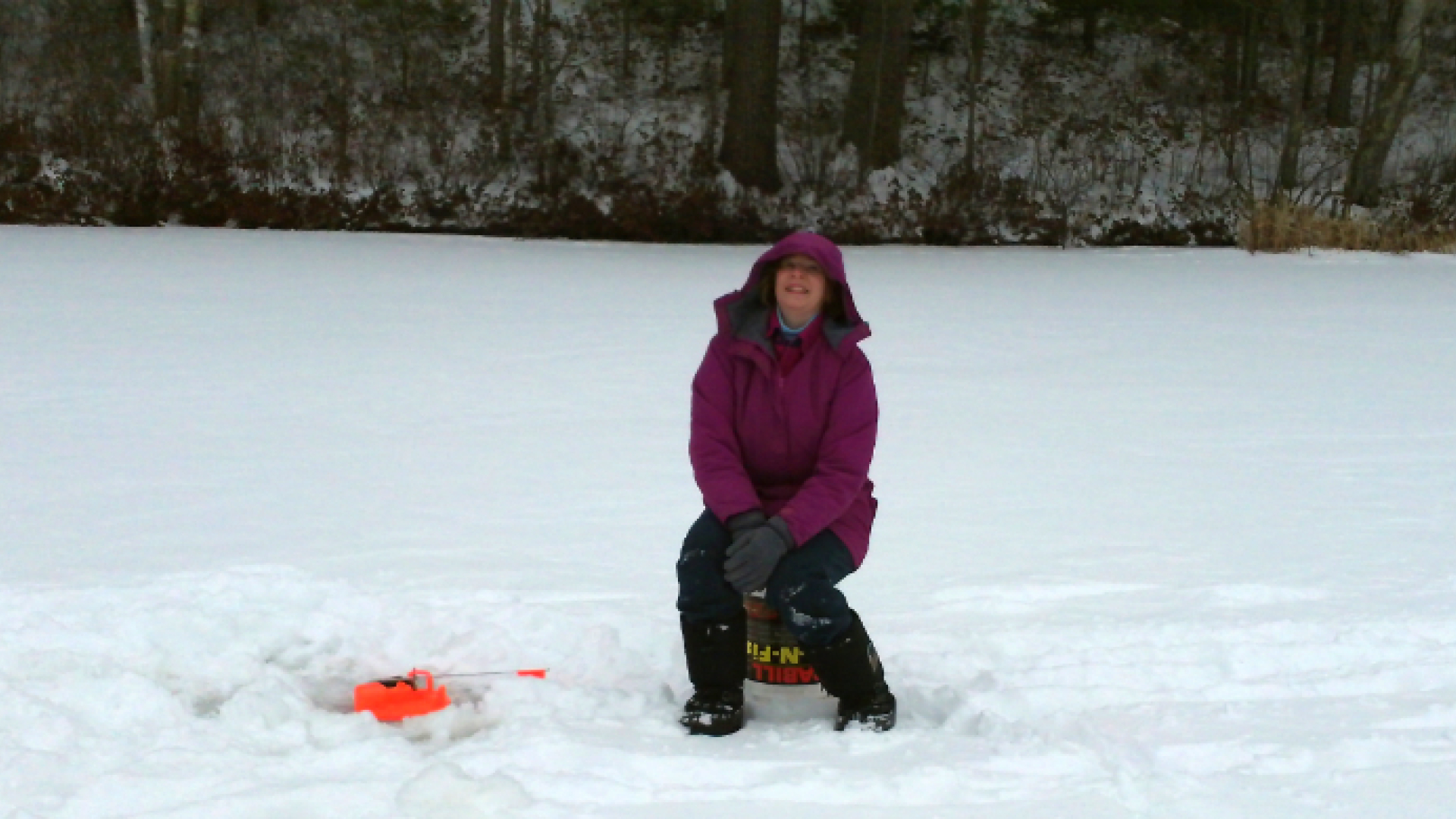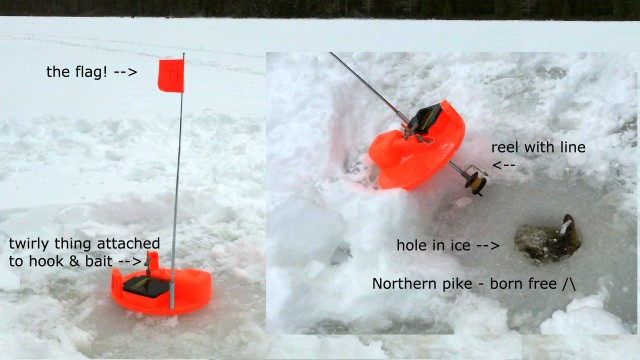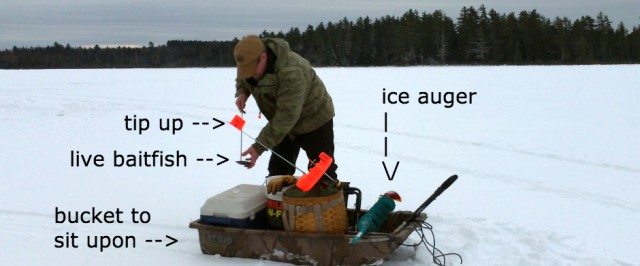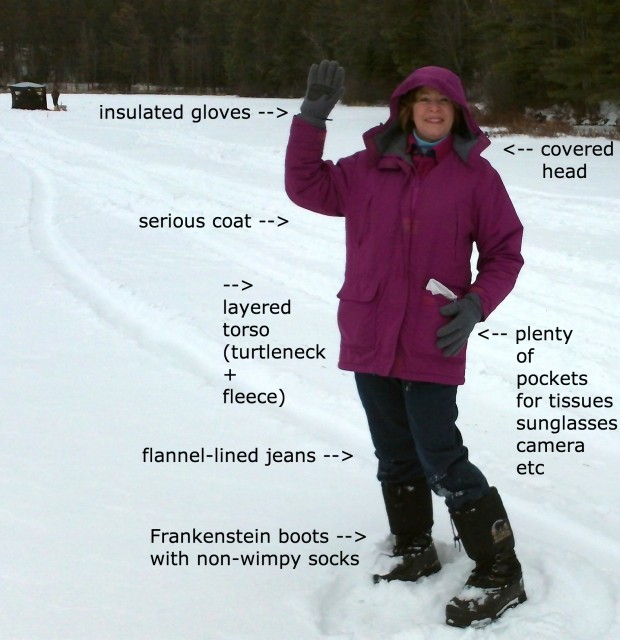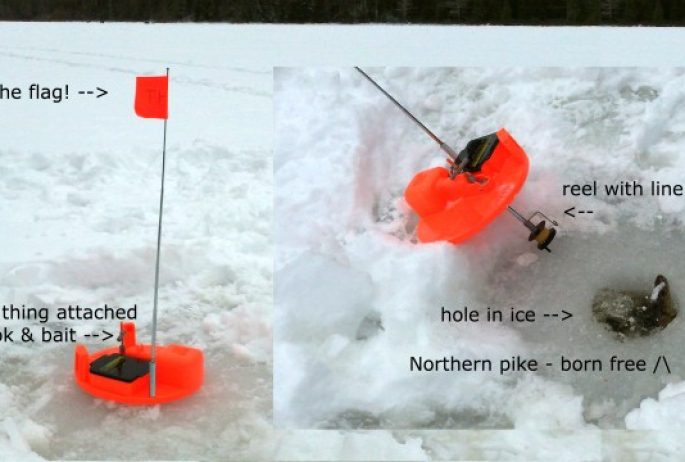With fishing a favorite pastime in the Adirondacks, it’s no surprise that our anglers don’t let low temperatures stop them. Ice fishing, aka hardwater fishing, keeps the fun going all the year 'round.
Saranac Lake is an ideal spot for the sport. It’s dotted with small lakes which are quick to freeze, and dotted with avid anglers who love to get out there. That fishing staple, the fishing pole, undergoes a bit of a transformation, but then the game begins.
ice fishing gear
The Tip-Up is what a fishing pole is called when it's used for ice fishing. While "just sitting there" is a wonderful part of boat fishing, it has drawbacks in colder temperatures. Besides, one of the best things about ice fishing is the socializing!
So the fishing reel is moved to the bottom of the bright orange (for visibility in snow) device, with a line, hook, and wriggling bait fish at the end. The flag is bent over and tucked under the twirly thing (as seen above.)
Fish get hungry under the ice, and we cannot do the balletic movements to make a lure look real. The bait has to be real. Up top, the Tip-Up is attached to a little gear (see: twirly thing) which holds down the flag, until the fish takes the bait. Then it pops up, and if we are watching, waves wildly for a bit to let us know something is down there.
As seen here, our first fish of the day was a Northern pike, but not a keeper. We released him back into the wild.
That hole was drilled with an ice auger, the other vital part of ice fishing. We have to get through the ice. On this day, it was between 11 and 13 inches thick, with 9 inches of clear, and thus denser and stronger, ice.
all the gear, plus a sled to get it there
There are hand-powered ice augers, but that's no fun. Battery powered models, like the one shown here, are far more popular, because we aren't going to drill just one hole. We will want to drill as many holes as we have Tip-Ups. This increases our chances of that thrill of the waving flag. Location can be a tricky and changeable thing, I was told. People sitting right next to each other can have wildly varying luck.
Is there a weed bed down there? Tricks of the light which make our bait look especially tasty? A current bringing in commuters? We don't always know.
Adirondack ice fishing includes perch, sunfish, pickerel, northern pike and walleye, almost anywhere. There are many waters which feature trout, lake trout and landlocked salmon. Whatever the quarry, live baitfish work for them all, so we are never sure what we might be pulling out when that flag starts rocking in the distance. Or, how big.
Don't forget our New York State fishing licences! These are available at sporting venues, like Blue Line Sports, or at Town Hall.
So we have our pole, our hole in the ice, and a baited hook. What else do we need?
Actually, not much. In fact, there are Tip-Ups who will dial an angler's cell phone to let them know the flag was thrown. But we're human. We aren't going to stop there.
A sled is a common sight for easy dragging of the equipment to where it's needed. That cooler on the left holds the baitfish. In this case, the insulation is to keep them from freezing. Though they can handle being frozen and thawed, getting them out and on the hook when they are in a solid block of ice is not a fun pastime.
It's always a good idea to bring snacks and drinks, too, which is what is in the pack basket. Just standing around in the winter means our bodies are working hard to keep us warm. Staying non-hungry and hydrated will help us feel warmer, too.
Ice fishing accommodations
Where we wait for that flag can be as basic as the classic upturned bucket, or as elaborate as one of those little shanties with curtains in the windows. Large expanses of water can sprout temporary cities, and this is where we often find the wooden shanties that have been popular for centuries. But in places with many venues, all weather tents with heaters are becoming more popular, as they have both comfort and portability.
Shelters are important on windy days or all day sessions, when having a place to warm up will keep spirits, and body temperatures, high. But they aren't necessary to enjoy ice fishing. A fine sunny day, or a windless one, can mean being comfortable in a rather wide range of temperatures. As soon as the temperature drops below freezing, so does all the moisture in the air. It's the water vapor which conducts the cold to our bodies. Dry air is far less efficient about it.
Whatever the structure, the fact that we don't need to monitor the Tip-Ups leaves us free to wander around and visit with the other folks out on the ice. People swap tips, trade tasty goodies, and compare experiences. Children enjoy watching for flags and the exciting reveal of the catch, whether it is one of theirs, or not.
This means we can be very comfortable if we simply dress properly.
Ice Fishing Wear
We need to block the wind and insulate to retain our body heat. But if we coordinate our outfits with this task in mind, we might be surprised at how comfortable we wind up being.
Start at the top. Traditionally, we have a hat, and a hood. Because most of the time we will have our hood down, to easily look for that waving orange flag. And we'll want a hat on, because even though just how much heat loss is comes from our head turns out to be an Internet controversy, everyone agrees they feel warmer having their head covered.
Our neck and torso need a lot of coverage, because that's our core. Also, having the wind whistle down our necks is one of the fastest ways to feel chilled. I chose a silk-blend turtleneck and over it, a tunic length fleece, for the best of both worlds. My parka is rated to -20, but as my Dad said when I bought it, "Of course, you'll want to layer."
I have gloves lined with an insulating material. Mittens are even warmer. But, not as dextrous. Your call.
My pockets contain tissues (for cold temperatures) and sunglasses (because the sun off the snow is almost twice as bright as the original source) and a camera, (to snap a photo of That Big One.) Flannel lined jeans are the goto if we haven't already put on our long underwear. It's a great extra layer we don't even notice.
Last, but far from least, is the right boots and socks. Because we are tramping around on a foot of ice, usually with snow on top of it. We want nice thick socks and good thick boots. How thick? Well, the ones shown here make me have to crank my front seat back a notch so I can still work the pedals on the car. But I was on the ice most of a day with no problems at all.
While we might have our cold weather clothing, we might not have Tip-Ups. Or a tent. Or an ice auger. Fear not!
The best way to learn ice fishing is at the upturned bucket of a Master of the art. Set up a trip with a local guide, and they will bring everything we could want.
